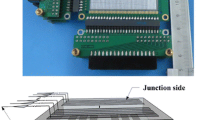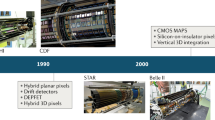Abstract
The unique properties of semiconductors makes them suitable for precise measurement of particle’s tracks and if placed in a magnetic field, high accuracy momentum measurements are possible. Silicon, with low band gap (1.12 eV) and electron-hole pair creation energy (3.62 eV) are very efficient to create a large number of charge carriers due to ionizing particle. High density (2.33 g/\({\text {cm}}^3\)) leads to large energy loss in detector bulk by ionizing particles, which gives access to production of thin detector with fairly large signal. With high electron mobility (\(\mu _e = \) 1450 \({\text {cm}}^2\)/Vs) and hole mobility (\(\mu _h = \) 450 \({\text {cm}}^2\)/Vs) silicon detector provides very fast signal. The Planner technology is widely used for fabrication of semiconductor detectors. The main steps of fabrication of semiconductor detectors are passivation, patterning, doping to form P\(^+\) and N\(^+\) regions, contacts. In this paper, the fabrication of Silicon Pad Detector at IIT Bombay has been described.
Access provided by Autonomous University of Puebla. Download conference paper PDF
Similar content being viewed by others
Keywords
These keywords were added by machine and not by the authors. This process is experimental and the keywords may be updated as the learning algorithm improves.
1 Introduction
Silicon strip detectors are widely used tracking sensors in high energy physics experiments. The strip sensor improves the spacial resolution of tracks of ionizing particles. When passing silicon bulk, particle produces a measurable signal proportional to energy deposited.
This section contain details of fabrication process of silicon detector using planar process. Figure 82.1 shows cross sectional view and of working of semiconductor detector [1]. The fabrication of silicon pad detector with active area of 5 mm \(\times \) 5 mm from n-type silicon wafer is described. The pad detectors fabricated on 2 in n-type silicon wafer with thickness of 250 \(\pm \) 15 \(\upmu \)m and (111) orientation. The resistivity of silicon wafer is \(3000{-}5000\,\Omega \) cm. To filter small DC current noise through contacts, a thin layer of oxide (\({\approx }100{-}200\) nm) is deposited between p implant and Al contacts. Semiconductor sensors operates in fully depleted voltage region, to ensure breakdown protection, an additional rings surrounds the sensor pad. These rings are called as guard rings and kept floating while measurement. This rings ensures definite drop of voltage along a larger distance and potential drop from one ring to another is adjusted via punch through biasing.
2 Silicon Pad Detector
The quartz sand (SiO\(_2\)) is abundant form of silicon in nature. For detector fabrication silicon wafer should have very high purity of 99.999999999 \(\%\) or better than 1/100 ppb [2]. Electronic Grade Silicon (EGS) wafers are used for detector manufacturing. Two famous single crystal growth techniques are Czochraiski (CZ) Silicon and Float Zone (FZ) Silicon [3]. The n- or p-type silicon wafers with different resistivity are produced by adding amount of dopants to the crystal during the production (arsenic or phosphorus for n-type and boron for p-type). FZ prime quality silicon wafer is used for fabrication of silicon pad detector.
Although the manufacturing of silicon detector uses a traditional processes in semiconductor technology, the great care has to be taken for low contamination with impurities during production. Any contamination of oxide or sensor bulk and uniformity over the wafer would increase leakage current through sensor and change the operating voltage. The following subsections describes production of silicon detector at IIT Bombay.
2.1 Thermal Oxidation
Silicon dioxide (SiO\(_2\)) or silica with dielectric constant of 3.9 is natural oxide of silicon and easily produced on silicon in very thin and uniform layers. Thin layers of SiO\(_2\) are deposited by heating the silicon wafer in an oxygen environment. Oxidation can be preformed at temperature 800–1200 \(^\circ \)C using either molecular oxygen (Dry Oxidation) or water vapour (Wet Oxidation).
The silicon wafer is cleaned using RCA cleaning process, which is a standard cleaning process for silicon to avoid contamination during oxidation. Thermal oxidation is performed using Pyrogenic wet oxidation furnace at temperature 1050 \(^\circ \)C in presence of H\(_2\) and O\(_2\) gasses. Thickness of SiO\(_2\) layer formed on silicon wafer is 630 \(\pm \) 10 nm.
2.2 Photolithography
Photolithography is used to transfer the layout that are designed to silicon wafer. The designed device structure is transferred to iron oxide film on glass substrate to prepare photomask (Fig. 82.3). Figure 82.2a shows a photomask design for silicon pad detector.
Patterning of SiO\(_2\) is done using double sided mask aligner. Silicon wafer is coated with uniform layer of UV light sensitive positive photoresist of thickness 2 \(\upmu \)m. It is then soft baked at temperature of 90 \(^\circ \)C for 5 min. The photoresist is then exposed to UV light through photomask using double sided mask aligner. After exposure, wafer is developed to remove exposed photoresist and transfer the structure from mask to wafer. There is possibility of under etching or over etching in this process and it has to taken in to account while designing photomask. Figure 82.4a shows silicon wafer with pattern of photoresist and SiO\(_2\). Figure 82.4b shows microscopic image of SiO\(_2\) pattern of one device.
2.3 Doping
To create the p-n junction, n-type silicon wafer can be doped using two methods either by ion implantation or by diffusion. Ion implantation is advantageous because, it can be performed at low temperature which prevents material deterioration and implantation profiles can be attuned precisely by proper energy and dosage of ion beam. To avoid channeling of ions, crystal axis is tilted by an angle of about 7\(^\circ \) to beam direction. For p-side i.e. top side doping, boron beam with an energy of 2 keV and a dosage of 5 \(\times \) 10\(^{15}\) ions/cm\(^2\). For n\(^+\) i.e. bottom side doping, arsenic or phosphorus beam of energy 2 keV and a dosage of 5 \(\times \) 10\(^{15}\) ions/cm\(^2\) is used. Once doping is done, high temperature treatment is necessary to activate the dopants. The sample is cleaned and annealed at 900 \(^\circ \)C under dry Nitrogen. Figure 82.5 shows doping profiles for optimised parameters of the process [4].
2.4 Metallization
Metallization is done to create contacts which are required for connection to readout systems. Al is widely used material to make contacts for Si detectors. Al can be deposited using Thermal evaporator and patterned by photolithography after ion implantation. Al must be very thin (\({<}500\) Å ) to avoid absorption and deterioration of energy resolution due to energy straggling. Aluminium spikes are much less likely observed in crystal with orientation (111) than on (100) surfaces. From this wire bonding can be done using Al wires.
3 Silicon Strip Detector
We have also started fabrication of single sided silicon strip detector using n-type silicon wafer of thickness 250 \(\pm \) 15 \(\upmu \)m. The prototype is of 2 cm \(\times \) 2 cm size with 50 \(\upmu \)m of pitch. Total active area is 1.92 cm \(\times \) 1.92 cm with total 384 strips. The dimension of pitch define the resolution of strip detector. The Guard rings surrounds the active area to protect it from breakdown. The bias to the strip can be done by two methods, polysilicon biasing and punch through biasing.
4 Next Steps
The immediate next step will be to characterize the silicon pad detector and test it with radiation source. Then we will proceed for fabrication and testing of prototype of single sided silicon strip detector.
References
J. Kemmer, Improvement of detector fabrication by the planar process. NIM A 226, 89–93 (1984)
Silicon Strip Detector for High Luminosity Hadron Collider—Marko Dragicevic
Semiconductor Radiation Detector—Gerhard Lutz
Plasma Immersion Ion Implantation Process Space Optimization for Semiconductor Device Application—Ashok Ray, MTech Report 2012, IITB
Acknowledgments
We are thankful to centre for excellence in nanotechnology (CEN) lab facility at IIT Bombay.
Author information
Authors and Affiliations
Corresponding author
Editor information
Editors and Affiliations
Rights and permissions
Copyright information
© 2016 Springer International Publishing Switzerland
About this paper
Cite this paper
Jadhav, M., Varma, R. (2016). Development of Silicon Pad and Strip Detectors in High Energy Physics. In: Bhuyan, B. (eds) XXI DAE-BRNS High Energy Physics Symposium. Springer Proceedings in Physics, vol 174. Springer, Cham. https://doi.org/10.1007/978-3-319-25619-1_82
Download citation
DOI: https://doi.org/10.1007/978-3-319-25619-1_82
Published:
Publisher Name: Springer, Cham
Print ISBN: 978-3-319-25617-7
Online ISBN: 978-3-319-25619-1
eBook Packages: Physics and AstronomyPhysics and Astronomy (R0)









